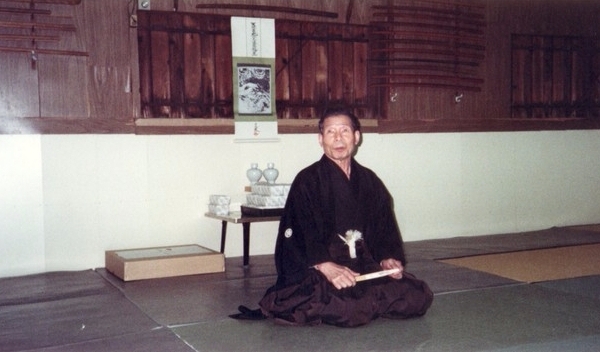 Sadao Takaoka Sensei (1916-2002) in 1993
Sadao Takaoka Sensei (1916-2002) in 1993
Sadao Takaoka was one of the lesser known direct students of Aikido Founder Morihei Ueshiba. He began training in O-Sensei’s home town of Wakayama in 1939, but he did not actually meet the Founder until well after the war, in 1951. And although he enjoyed a personal relationship with the Founder and often participated in the annual All Japan Aikido Demonstrations held in Tokyo, he remained on the outskirts of the Aikido world and is largely unknown today.
He was one of the few people that had the opportunity to act a a training partner for Morihei Ueshiba when he was refining his weapons system after the war, as mentioned by Shigenobu Okumura Sensei:
Q: In a previous interview you said that you had seen such things as Sho-chiku-bai Sword (松竹梅の剣 / “Pine-bamboo-plum Sword”) and Gogyo Sword (五行の剣 / “Five Elements Sword”)…
A: I think that those things were still going through a period of trial and error. So Saito-san from Iwama and Sadao Takaoka-san (高岡貞夫) from Wakayama were used as practice partners during that process of trial and error.
He was also Yoshinkan Aikido instructor Tsuneo Ando’s first Aikido teacher (see “Talking to Tsuneo Ando Part 1 – the Gozo Shioda that Nobody Knew“).
In this essay Sadao Takaoka discusses his early experiences with Aikido before, during and after World War II, and his experiences in meeting Aikido Founder Morihei Ueshiba. There is also an Appendix in which Takaoka Sensei discusses some of O-Sensei’s teachings.
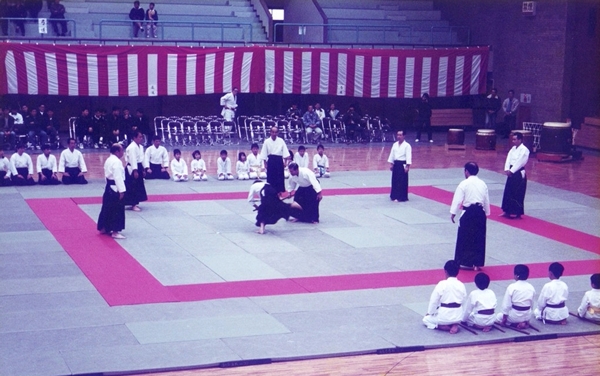 Sadao Takaoka Sensei at a demonstration in 1993
Sadao Takaoka Sensei at a demonstration in 1993
Aikido Shihan Sadao Takaoka – Meeting O-Sensei
by Sadao Takaoka
The Birth of Aikido in Wakayama
The birth cry of Aikido in Wakayama came in Showa year 14 (1939) when I met a student of Aikido, Hiroyuki Nozawa Sensei. I’d like to talk a little bit about my history prior to meeting Nozawa Sensei.
My uncle was a circuit priest. We would set up an image of the Buddha in our house twice a month on the first and the fifteenth, and many of the faithful would come to pray. There were also believers in Kii Tanabe, so my uncle would often go there as well. In Showa year 8 (1933) I was seventeen years old. When I spoke to my uncle about wanting to learn Judo he told me that there was an instructor teaching a “mental” budo (“seishin budo” / 精神武道), but when we went to see my uncle’s friend Mr. Egawa we found out that the instructor had moved to Tokyo. That instructor in Kii Tanabe was Ueshiba O-Sensei. I often heard stories about Ueshiba O-Sensei from my uncle.
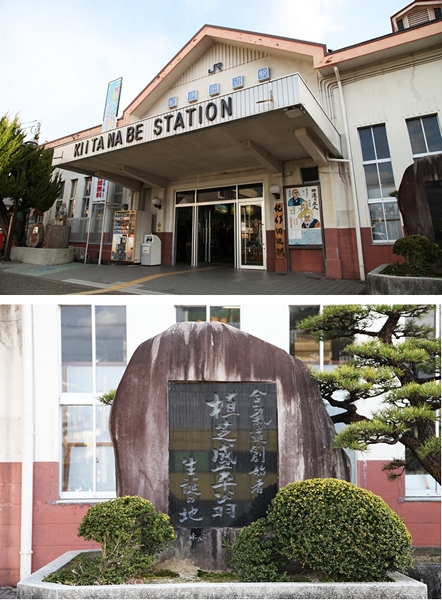 Kii-Tanabe train station and the memorial to
Kii-Tanabe train station and the memorial to
Aikido Founder Morihei Ueshiba
So there I was. I wanted to learn some kind of budo, so I learned koryu Takenouchi-ryu grappling. I learned from a teacher named Kusutarou Mizutani (水谷楠太郎), and there were a lot of anecdotes about him. One of those was the happening at the Wakayama-shi train station. The baggage handlers for the train station and the baggage handlers for a shipping company got into a fight, but they became angry when Sensei attempted to intercede – “this is none of your business!”. “Well then, I’ll take all of you on – come at me!”, he said and beat all of them about the platform. An Osaka police officer who saw this suggested that Sensei become a detective, and he did that work for a while but it didn’t suit him so he soon resigned. He established a dojo and began teaching, and I heard that as rumors of the incident at the train station spread he began to attract large numbers of students.
Mr. Tsuda, who was one of Mizutani Sensei’s senior students, took responsibility for my instruction, and thanks to being the youngest student there he would tell me many of the secret methods by oral transmission (“kuden” / 口伝). He would also guide my education in budo with tales of Itto Ittosai‘s (伊藤一刀斎) students Ono Zenki (小野善鬼) and Mikogami Tenzen (神子上典膳).
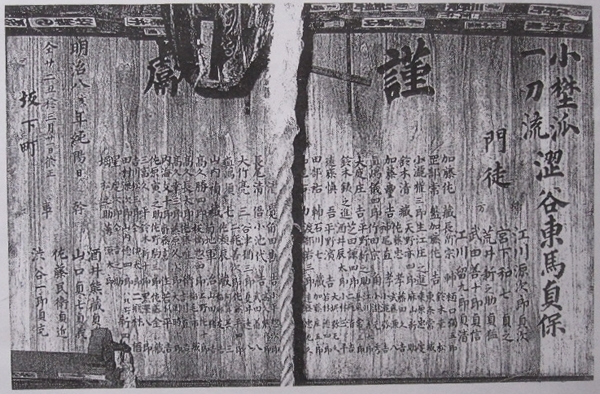 The name board for Shibuya Toma’s Ono-ha Itto-ryu Dojo at Enzoji Temple
The name board for Shibuya Toma’s Ono-ha Itto-ryu Dojo at Enzoji Temple
Ono-ha Itto-ryu is the oldest of the Itto-ryu branches founded by Itto Ittosai
The 18 year old Sokaku Takeda’s name appears seven from the right in the center
About three years after I started training in Takenouchi-ryu grappling my uncle told me to go with him during his shugyo and we went up to Gongendo (権現堂) in the mountains to do zazen and misogi under the waterfalls. My uncle showed me and taught me many mysterious things. For about five years I would participate in his shugyo once or twice a month.
In Showa year 13 (1938), I started training in my home, training with about ten people. From December 25th of that year my youth group began the year-end night patrols, and I was responsible for the last day of the year until dawn on New Year’s Day.
The gathering place for the night patrol was at a movie theater called Denki-kan in Motoderumachi, Mr. Hiroyuki Nozawa had been sent from Kyoto and assigned to that location.
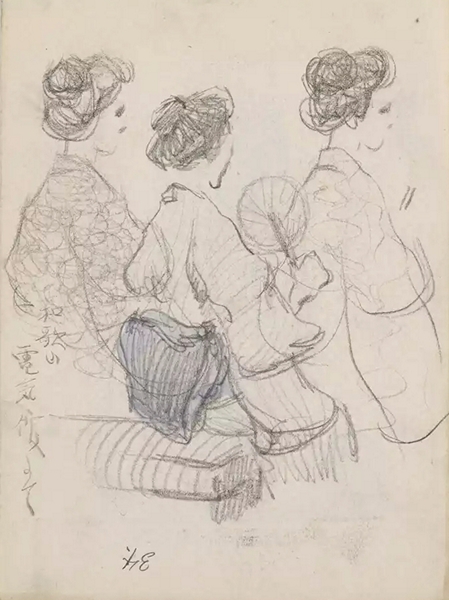 At the Wakayama Denki-kan – by Kyokichi Tanaka, 1910
At the Wakayama Denki-kan – by Kyokichi Tanaka, 1910
All of a sudden he said, “Are you Takaoka-san? I hear that you teach budo.”. I said “no”, and then he said “someone from yesterday said your name”, with a suspicious look on his face, so I said “I’m just fooling around”. “What rank are you?”, he asked, and I replied, “It’s a koryu, so I receive sections of the curriculum”. When he said, “Do you know what Aikido is?” and I said “That’s Ueshiba Sensei from Kii Tanabe, isn’t it?”, he said, “So you’ve heard of it?”. I told him, “It was Ueshiba Sensei that I went to call on in Showa year 8 (1933) , when I thought about learning budo.”. Then he invited me, “That’s great, shall we try touching hands?”.
When we trained together the form of the techniques was the same, so Nozawa Sensei and I started teaching Aikido together in my dojo. After training for a while we received a request from the police, and when the two of us went to teach them the Military Police approached Nozawa Sensei with an order to “teach Aikido to the army personnel”, so we went to teach at the command center. A short time after that, the two Aikido Shihan Yukawa Tsutomu (湯川 勉) and Tetsuo Hoshi (星 哲臣) showed up and I was taught as well. Both of the Shihan had very powerful (hard) technique.
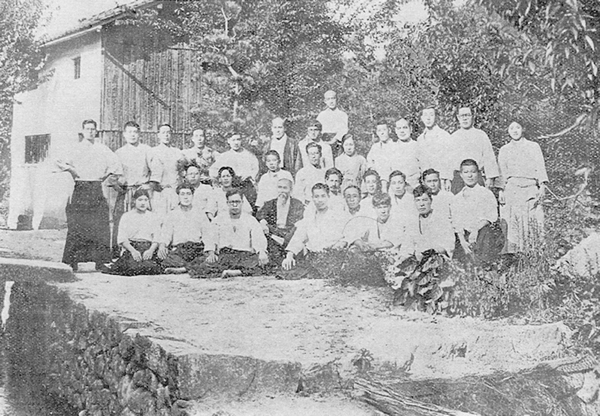 1934 Summer Training – front row from left:
1934 Summer Training – front row from left:
Kiyoshi Nakakura (standing), Rinjiro Shirata (seated), Tsutomu Yukawa (seated)
From the Kobukan Dojo newsletter “Kobu” (皇武)
Translator’s Note: Tsutomu Yukawa was one of Morihei Ueshiba’s favorite students (he was actually married to Morihei Ueshiba’s niece), and was famous for his great strength. He died in a knife fight in Osaka in 1942. Tetsuo Hoshi was a Judo sixth dan who returned his rank to the Kodokan after meeting Morihei Ueshiba. He was later executed as a WWII war criminal for torturing prisoners of war with his martial arts techniques (from “The Way of Judo: A Portrait of Jigoro Kano and His Students“, by John Stevens).
Nozawa Sensei had also studied Kurama-ryu (鞍馬流) before doing Aikido, so he also practiced a lot of striking techniques. Nozawa Sensei used to say that at the time that he studied at the Aikido Kansai-shibu Takeda Dojo that all of the students who came to train held certificates in other ryu-ha (“schools”).
After that, I began teaching Aikido to the general population in Showa year 18 (1943). In order to avoid provoking the command center I made up another name for Aikido – changing the “Takenouchi” in “Takenouchi-ryu” from 竹内 to 武内, I called it “Takenouchi-ryu Tessen-jutsu” (武内流鉄扇術) when I taught.
Memories of my military service
During my training in budo with Mizutani Sensei I learned methods of healing through bonesetting and shiatsu, and being asked by my students I would sometimes give them healing treatments.
In Showa year 18 (1943) , during basic training a few days after I enlisted, I was called into the petty officer’s room by the squad leader – “You said that you didn’t have a girlfriend, but who is this!?”, he said, and showed me a letter. It was a pink envelope. The squad letter opened the envelope and read the letter, but it was a thank you letter from one of the people that I given healing treatments to before I enlisted.
I was asked, “You do budo?”, so I gave him an explanation of Aikido. The training officer, who had been listening, said, “Come teach me before lights out”. In this way, I was able to avoid the usual hazing from the troops before lights out.
I completed my three months of basic training without incident and returned home. When I reached foreign soil as part of the third call up for Showa year 20 (1945) I was soon called to the medical office, where the army medic said “I gave this man two shots of the anaesthetic but the pain won’t stop. You try treating them.”. After treating him for around twenty minutes the pain went away, and the army medic said that he would tell general headquarters that I was to work in the medical office starting the next day, and that was how I came to work there.
Soon after that it came to the end of the war, and about a week before I thought that I would be able to return home an order was issued for personnel at the aviation factory in Gwangju (Korea) and I was unable to return home. At the time I was treating the adjutant to the battalion commander, and when I went to tell him that I would be unable to treat him from the next day he said that would be a problem and told general headquarters that I was essential personnel and that he wanted them to change my assignment.
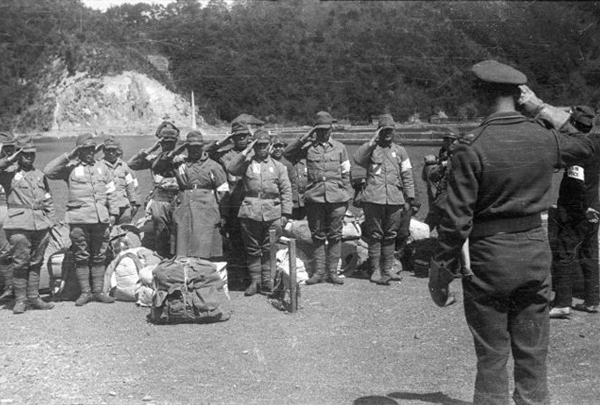 Repatriation operations at the port of Senzaki, Japan
Repatriation operations at the port of Senzaki, Japan
Original caption reads: “NZEF in Japan. Repatriated Japanese soldiers salute a New Zealander, Major L W Wright, as he approaches. Orders have been issued that all occupation force troops must return salutes given by Japanese. These Japanese are passing through the port of Senzaki, where New Zealanders are in control of repatriation operations.” Photograph taken ca 1946 by a New Zealand Army photographer.
On October 15th of Showa year 20 (1945) I arrived at Senzaki Port to the nostalgic mountain skyline of Japan, boarded the train for the demobilization returnees, and when I opened my eyes was arriving at Tennoji Station in Osaka.
I got on the Nankai Electric Railway, but when I arrived at my long forgotten Wakayama City it was a burnt out ruin. I thought to go and see the burnt remnants of our home, and all that was left of that terrible tragedy were the burnt and crusted remains of our metal utensils.
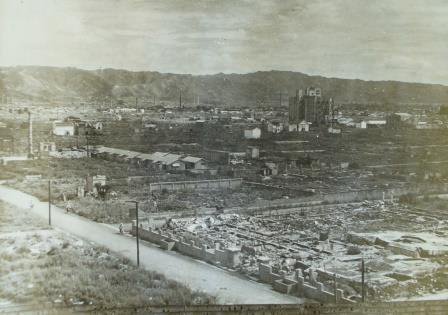 The remains of Wakayama City after the 1945 air raids
The remains of Wakayama City after the 1945 air raids
I immediately became concerned for my family, but when I went to call on my uncle in the country my family were all unharmed,
In retrospect, I am grateful that I was able to return home quickly and unharmed thanks to budo.
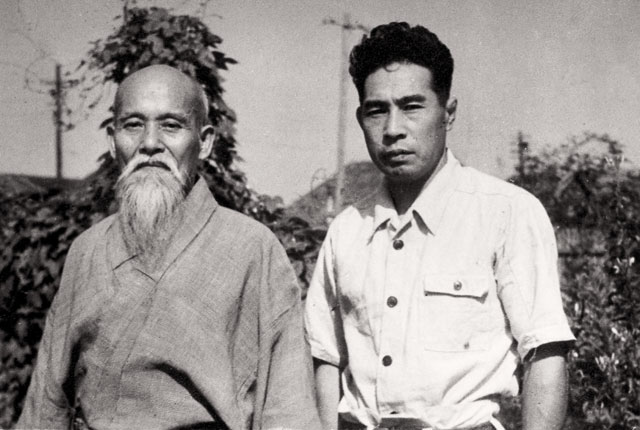 Morihei Ueshiba and Minoru Mochizuki around 1951
Morihei Ueshiba and Minoru Mochizuki around 1951
Meeting Morihei Ueshiba O-Sensei
After the demobilization I was teaching Aikido to the young people in the rural evacuation areas when one day a young person that I had never seen before came to me and said “I’d like to train with you”. Although I said “today is a day off” he insisted, so I said “well then, right here” and I showed him two or three techniques in that six tatami room (about 9.18 square meters, or 98.8 square feet), but when I said “that’s it for today” he showed no signs of leaving. I asked him “is there something that you want?” he said “actually, I’m a student of Judo and I’ve never seen techniques like these”, and when I told him “nobody knows these techniques, so I’m teaching them in gratitude for the help they gave me in demobilizing” he said “thank you” and left.
The next day when I was talking to the students they said “Did he show up? He said that he was going to toss that guy with the strange techniques around.”, so I said “Is that right? I’m glad that I didn’t get thrown then.” while laughing, and everybody exploded with laughter. It’s a good memory of the evacuation area.
In January of Showa year 22 (1947) I moved from the evacuation area to Nakanoshima in Wakayama City.
In Showa year 23 (1948) the president of the Nakanoshima Community Association, Mr. Youzou Shima, said that he wanted to help those pure youths who had lost their hope and were falling into the depths of depression, and asked me to teach them Aikido.
We turned the workshop at the Shima home into a dojo, and trained there day and night as Nakanoshima Dojo.
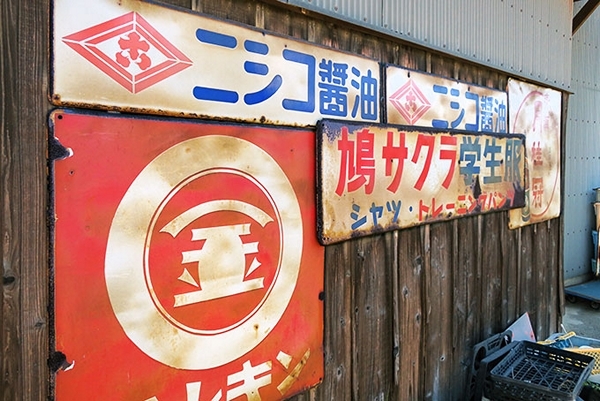 Old Nikko Shoyu (now Daisho) signs in Osaka
Old Nikko Shoyu (now Daisho) signs in Osaka
In Showa year 26 (1951) I was fortunate to learn that Aikido Founder Morihei Ueshiba O-Sensei would be returning for the first time in fifty years. At the request of Mr. Nishimoto (西幸醤油 / Nikko Shoyu) from the public safety committee he was to teach the members of the Wakayama police department.
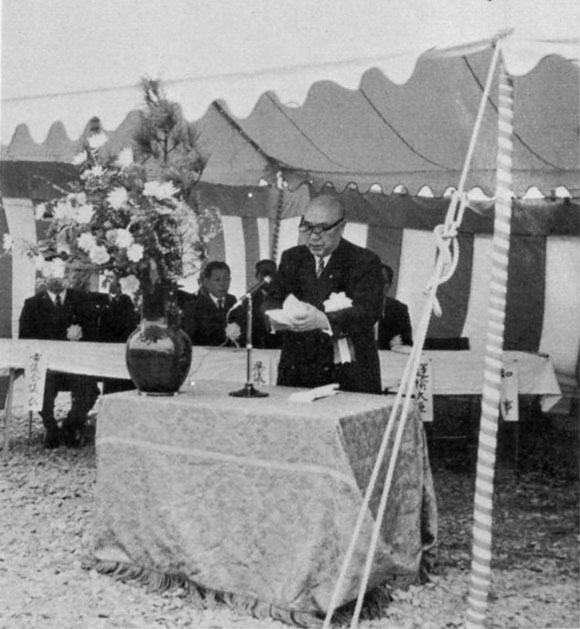 Wakayama Prefecture Governor Shinji Ono
Wakayama Prefecture Governor Shinji Ono
Through an introduction from Nozawa Sensei I was able to receive instruction along with the police officers, and for the mornings and evenings on Tuesdays, Thursdays and Saturdays at the Wakayama Prefectural Workers Community Hall with Governor Shinji Ono (小野真次) we would recieve instruction in Karate, which was born in Okinawa, from the instructors Otsuka, Tomoyose and Yamashiro, and then on Mondays, Wednesdays and Fridays O-Sensei would come to Nakanoshima Dojo with his high-ranking student Koichi Tohei (now head of the Ki Society).
Thanks to this that the dojo was overflowing with energy, and the number of students suddenly jumped to more than one hundred. In Showa year 28 (1953) I was promoted to third dan in Aikido and registered with the headquarters as an Aikido instructor.
After training, when I would say “Shall I give you shiatsu?”, he would say “In the past my students gave me shiatsu, but now there’s nobody who trains in shiatsu anymore. Maybe just once?” and lie down on his side.
As I was giving him shiatsu he said “You belong to this path. Have you thought about trying the Nishi Health System?”. When I told him that I wanted to learn his techniques first he said “Is that right? Well then, let me teach you my healing method.”, and then he taught me his palm healing method.
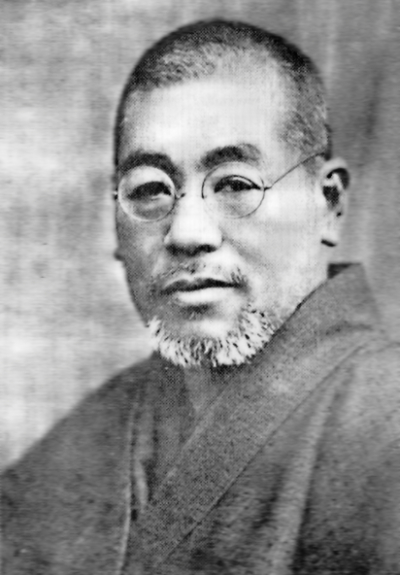 Reiki Founder Mikao Usui 1865-1926
Reiki Founder Mikao Usui 1865-1926
Translator’s Note: “Palm healing” is a kind of hands on healing that was often practiced in Japan as an element of Buddhism. It is commonly used as a technique in Reiki, founded by Mikao Usui in 1922. Both Morihei Ueshiba and Onisaburo Deguchi were said to have been acquainted with Mikao Usui.
When I mentioned to O-Sensei that his ribs were quite thick he said “My ribs are all one sheet. One time in the old days an instructor at the Toyama Academy stabbed me with a wooden bayonet. I did some reckless things back then.”.
Let me talk about some of the various anecdotes that the Founder told me.
The Founder was returning from harvesting when when he heard a voice saying “hey, hey”. When he put down his bale of wheat and looked around the village headman and the constable had been knocked down in the field . They scolded him because his bale was too wide to pass through.
He told me that in Ayabe, even when he returned from the main shrine late at night his wife would leave the door unlocked for him “I’ll tell you this because it’s you, but I don’t tell everybody.” he said. Then I asked him about a story that I had read in a book about the beam in the ceiling of the main shrine at the Omoto compound in Ayabe. “When I looked at the logs my body grew warm and the log looked like a small chopstick. It moved when I rocked it so I picked it up.” he said.
I heard this one from one of his students – “The Founder is strong, after practice he puts water in a basin and cools his hands,”.
When I trained with him he was so soft that I asked him if I would be able to produce as much power as he had before the war if I did this training. O-Sensei replied “Before the war I trained with strength without understanding. Now that strength is not necessary. This is Takemusu Aiki!”. Then he explained the reasons to me.
In the year that the war ended I became ill and my spirit became weak. As I thought of going to heaven an angel came to fan my flames. When I tried to leave even then a lone priest appeared and told me to return. He explained that it was too soon to see his face, that I was not yet cultivated enough.
After that I recovered from my illness. When I thought to go to offer prayers at the Aiki-jinja I saw a white man on the front path. Looking closely I saw that another Ueshiba holding a wooden sword standing in kamae, and when I went to strike him I was struck. When I struck again I was struck again. When I took a stance the next time he vanished suddenly. From that time my techniques became soft. The is Sho-chiku-bai Kenpo (“the Pine-bamboo-plum method of the sword”).
 Pilgrimage to Mongolia in 1924
Pilgrimage to Mongolia in 1924
Onisaburo Deguchi, second from left
Morihei (Moritaka at the time) Ueshiba on the far right
He often spoke to me of the time that he went to Mongolia, and when he spoke of falling in the lake he warned me “Takaoka, you are the only one who can protect yourself.”.
The memories of those conversations with the Founder left a deep impression on my heart.
A short time later the instructors Katsuki and Arikawa came from Hombu to teach.
In Showa year 30 (1955) a dojo just for instruction from O-Sensei was born in Masago-cho (真砂町), so the Nakanoshima Dojo members also started to go there to train.
Soon it was time for O-Sensei to return to the capitol, and I was told to come every morning at five o’clock so that he could give me shihan training in Tokyo. Every day for a week I learned the teachings (法則) while shivering in the light from O-Sensei’s eyes. On the last day he said:
I have given you my treasure. I could take back an object, but I can never take away the principles that I have taught you up until today. If you can understand what you have been taught then it is alright to tell others, but while you still don’t understand you must not. Train as long as you have life.
Translator’s Note: The 1955 shihan training sessions in Tokyo began with O-Sensei wielding a Jo in “Kagura Mai” (神楽舞 / “Dance of the Gods”). When questioned about technique during the training sessions O-Sensei would just repeat the “Kagura Mai” without saying a word.
Yasuo Kobayashi Sensei said this about that seminar: “In the spring of 1955, a special practice was held for yudansha from all over Japan at Hombu Dojo. The various instructors from Hombu joined with Sunadomari Sensei from Kyushu, Tanaka Sensei of Osaka, Hikitsuchi Sensei of Wakayama and from Tohoku, Shirata and Otake Senseis and others along with us deshi for a week of practice sessions. The last day there was a party which was attended by Shioda Sensei of the Yoshinkan, Katori-Shintoryu’s Sugano Sensei, Ninjutsu’s Fujita Sensei, Matsuo Sensei of Iaido and many other noted martial artists. Sensei representing the various schools of Aikido were also invited along with the old officer class of the Navy; everyone had a pleasant interchange.”
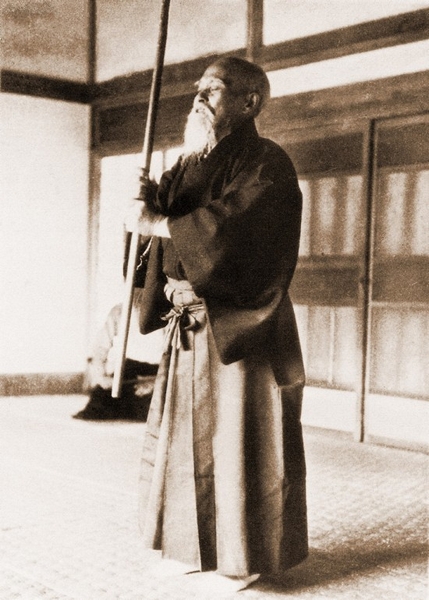 Aikido Founder Morihei Ueshiba
Aikido Founder Morihei Ueshiba
Kagura Mai – the Dance of the Gods
Appendix:
Dobun (instructive principles) by Morihei Ueshiba.
As taught by Sadao Takaoka Shihan, Wakayama Aikikai dojo
(originally appeared on The Aikido F.A.Q.)
Original translation by: Haruko Kado
Recompiled in English by: K.C. Brodbeck
Parts taken from Aikido Newsletter 2/10/1974
One spirit
Four souls
Three elements
Eight powers
Mototsumitama (literally translated as the Great Basic Metaphysical Substance of being) of the one spirit, four souls, three elements, and eight powers, make up the Great God. The Great God is the living infinite mother who has spread spiritual and physical prosperity throughout space.
Space was once empty, with no Heaven and no Earth. Suddenly a pinhole opened up in this empty space. This pinhole was the very origin of existence. From this hole, Ki of the Great God, which was finer than steam, smoke or mist, gradually came forth to form a circle which surrounded the pinhole and gave birth to the Kotodama of Suu. This birth was not only the birth of the physical world, but of the spiritual world as well.
The universe then began its natural respiration taking a deep breath of expansion, and as it expanded sound flowed from it. This original sound was the kotodama Suu. Suu then continued expanding in four directions and formed a pulsating circle. When Suu has developed it turns into U. The constant work of Suu produced the kotodama U.
The kotodama U, which is the origin of spirit as well as substance, divides into two and works as opposing forces which function independently. Each of these two functions has its own Mitama (spirit). One of these forces flows up and generates the kotodama A, while the other function falls to Earth and creates the kotodama O. With A going up and O going down an opposing force is created, and held together by Ki, an attraction is formed.
Takamagahara ( high planes of heaven ) represents the universe. It teaches us what the law and order of the universe should be and how the gods reside within it. Everyone s family represents Takamagahara and each individual has Takamagahara within him\herself. All the elements of this universe constantly breathe and flux and live every moment of our lives. In other words, Takamagahara is the great celestial globe which has successfully accomplished its formation and wishes. It is the very origin of creation of heaven and earth. To come to understand the wishes of Takamagahara and pursue the tasks of the gods to satisfy their will is Aikido.
Clarify the Ki of space, the Ki of the self-curdling island (Onogorojima), the Ki of the universe, and all the ways which mitama come into your body. Make all the breathings of the universe match your own. Use these lines as the law, and make them accomplish the mission of the universal heaven. The basic principle to pursue in each direction is called Aikido.
Aikido should be the doctrine endowed by god to clarify the workings of the universe. The past, the present, and the future are the routes which the universe should follow. This includes the human body, as it has the universe within it. Purify the universe and harmonize it with the three worlds of the manifest, the spiritual, and that of the gods. Following this continually is Aikido.
The core of the universal dynamism consists of 75 sounds. Each one of these sounds obeys three rules: triangle (Iku-musubi), circle (Taru-musubi), and square (Tamatsume-musubi).
The kotodama, A, O, U, E, I, manifesting the mind of the Founding god ( Kuni no Katachi no Kami), interacting with the neutral god (Toyokumo no Kami), the functions of the Five gods came into being.
When the eight powers interact with each other, the light, pure ones went up to the heavens, and the heavier, impure ones fell to the Earth. Each time the heavens and the Earth interacted, some functions fell to Earth, expanding it. This was done by the god of Tamatsume-musubi. With the three elements, Iku-musubi, Taru-musubi, and Tamatsume-musubi, influencing the process, the universe grew and continues to grow today. Aiki is this interaction and use of kotodama. It is the one spirit, four souls, three elements, and the eight powers.
One, two, three, four, five, six, seven, eight, nine, ten, one hundred, one thousand, one million, and the great Mitama of all These words represent the one spirit, four souls, three elements, and the eight powers. Ueshiba Sensei never failed to recite these words in his prayer before and after Aikido practice in order to teach us to assimilate ourselves within the universe. By doing so, we can produce techniques which make the three elements visible in the manifest world. Wishing for world peace, Ueshiba Sensei always preached that human beings are also a part of the universe.
The Three Elements
Ueshiba Sensei told us in his Dobun that the Three Elements are gas, liquid, and solid. After studying this for a long period of time, I came up with my interpretation for this. I think that these three elements are three stages. When O Sensei said gas, he wanted to tell you to match your breath with that of your opponent. Liquid indicates that you should absorb your opponent s strength. Solid implies that you should use your breath and perform the technique. In other words, in the gas stage we should lead our opponents with our Ki. In the liquid stage we should assimilate ourselves with our opponent. In the solid stage we gradually apply ourselves in the desired directions to complete the technique.
The Four Souls
Historically in Japan four separate aspects of functions of mitama have been recognized. The first is Kushimitama, or the heavens, which give light to all things in order to purify their KI. The second is Sachimitama, or the Earth, which lavishly provides and never expects anything in return. The active and valiant Aramitama, or fire, is indispensable for any type of development. The harmonious Nigimitama is the water that can flow anywhere and rules the Earth.
The Eight Powers
The eight powers are always contrastive to each other. Moving force and stopping force, dissolving force and curdling force, pulling force and releasing force, joining force and separating force, work actively in the universe to sustain life and the Earth. This is also true within ourselves, as we are part of the universe and have a universe within our bodies. I draw an analogy from the Ken-zen-ichi-jyo sword tactics which were written in the twelfth century. In Ken-zen-ichi-jyo we learn that if an opponent gives you his full 100% attack, you should receive the attack with zero. If he gives you 90% then you receive it with 10. 80-20 70-30 60-40 40-60 30-70 20-80 10- 90 0-100. I believe this is much easier to understand than the definitions given by O Sensei If we meet 100% with 100% we end up with a 50-50 connection and we cannot proceed with the desired function.
Fire and water are two basic examples of the opposing powers. Fire naturally flows vertically, while water flows horizontally. Water puts out fire, and fire evaporates water.
Many people ask about Aikido with relation to religion. I don t believe in religions because I know that history has seen a lot of conflicts among religions which have caused many great battles. Instead I believe in the god of fire and the god of water. It is such a simple concept that I wish people all over the world could come to support the idea.
The final set of contrastive powers is positive and negative. When explaining these two forces I use the terms plus and minus.
Correct breathing is critical to using these forces effectively. Take a breath as you pronounce A, O, U, E, I. Try to let your body learn to breathe the kotodama, and not your brain. In doing so you will not need commands from your brain to move as quickly as possible.
In Aikido, zero (or nothingness) is necessary most of the time. Kokoro (heart and mind) is one thing while Ki is something else. Many people believe that they are identical, but it they are not. Heart and mind remain innocent for your entire life, while Ki is always fluctuating. You must purify yourself to become nothing. What you do in Aikido never fails to reflect the state of your Ki. If your Ki is clouded, you cannot accept or lead your opponent. I really hope that everyone can learn to master the Aikido that Ueshiba Sensei taught and lived.
Published by: Christopher Li – Honolulu, HI

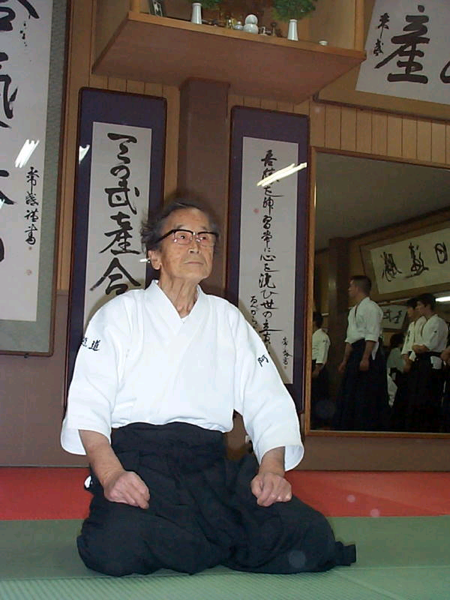
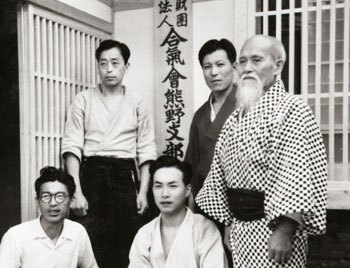
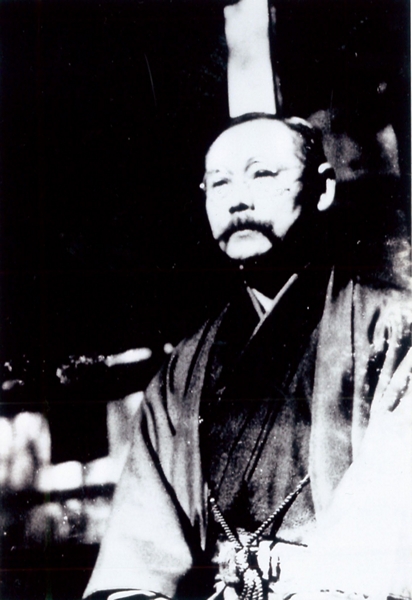 Dr. Kenzo Futaki
Dr. Kenzo Futaki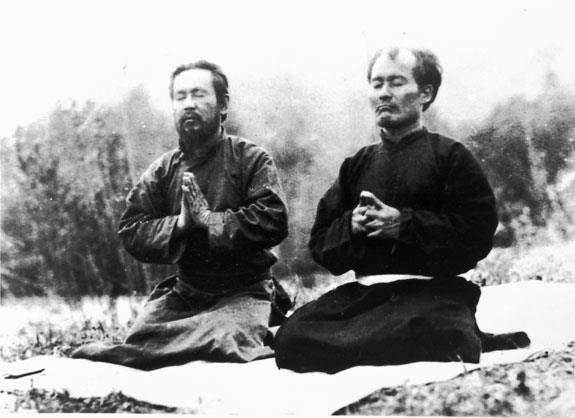 Omoto Priest Masumi Matsumura and Morihei Ueshiba
Omoto Priest Masumi Matsumura and Morihei Ueshiba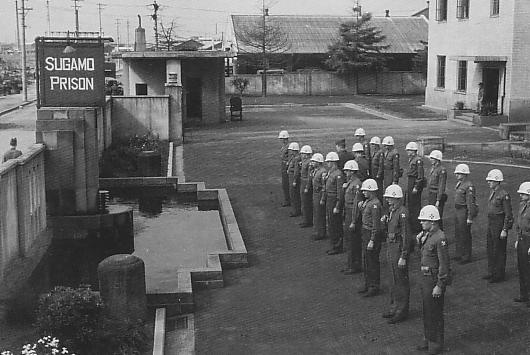 Guards at attention at Sugamo Prison, 1948
Guards at attention at Sugamo Prison, 1948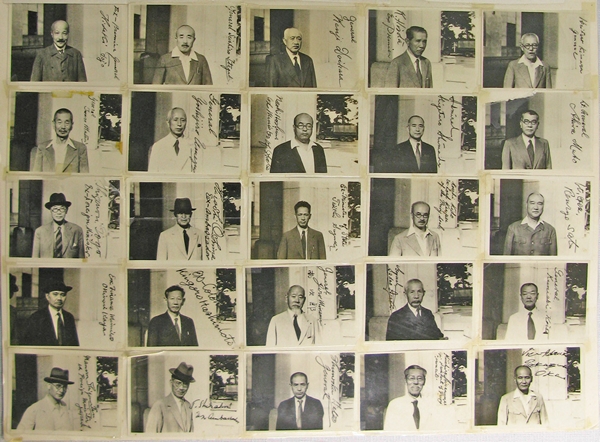 Signed photographs taken at Sugamo Prison
Signed photographs taken at Sugamo Prison 

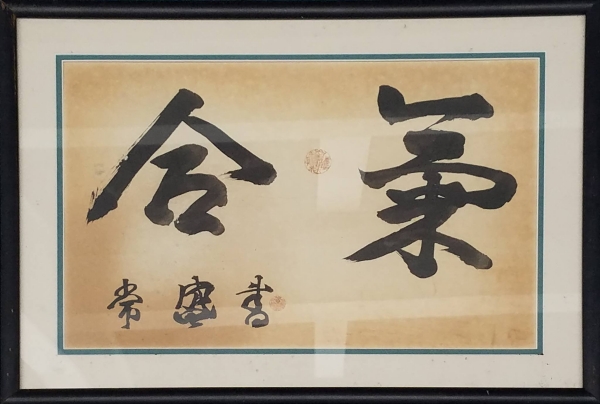 “Aiki” calligraphy by Morihei Ueshiba
“Aiki” calligraphy by Morihei Ueshiba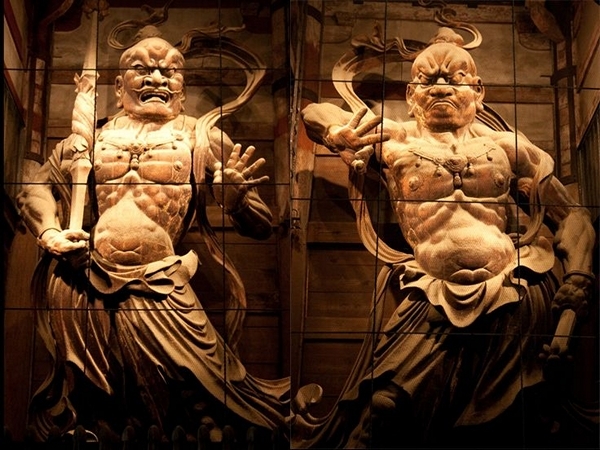
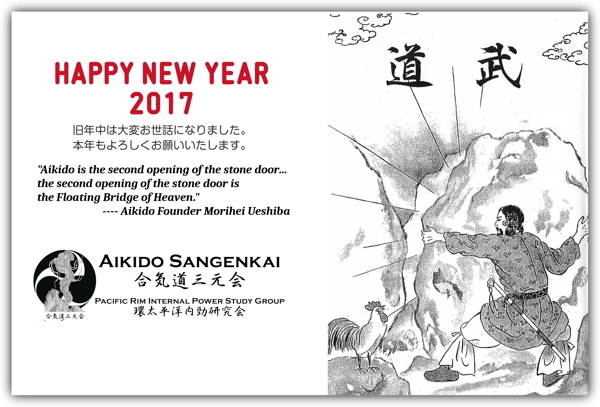
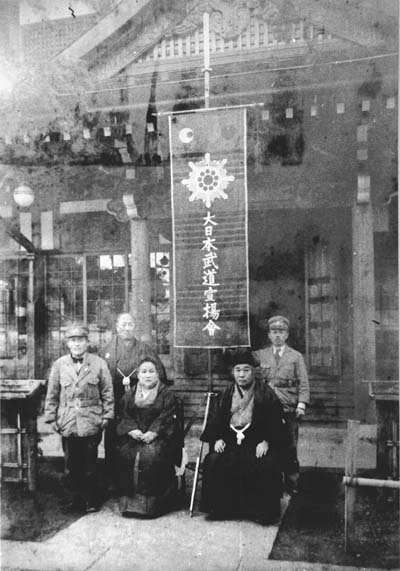
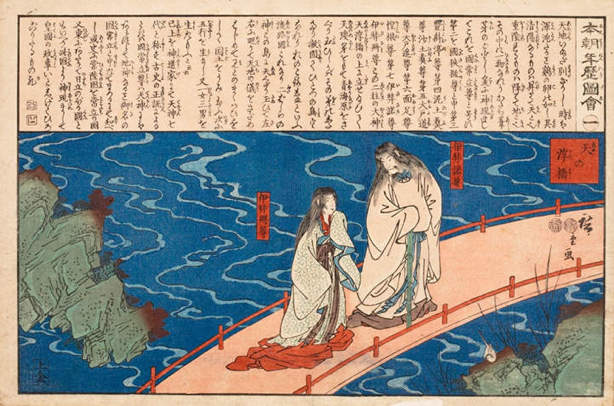 The Gods Izanagi and Izanami on the Floating Bridge of Heaven
The Gods Izanagi and Izanami on the Floating Bridge of Heaven 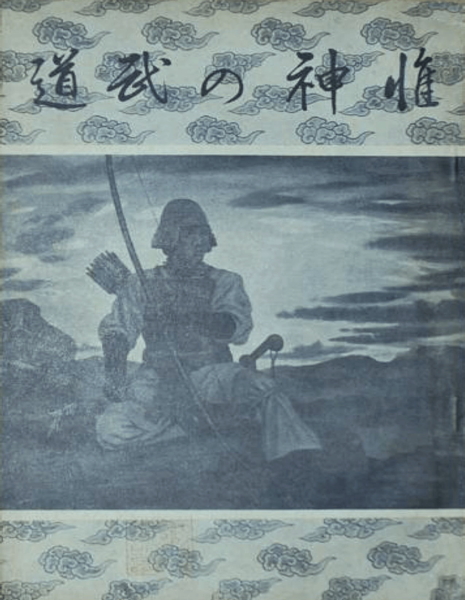
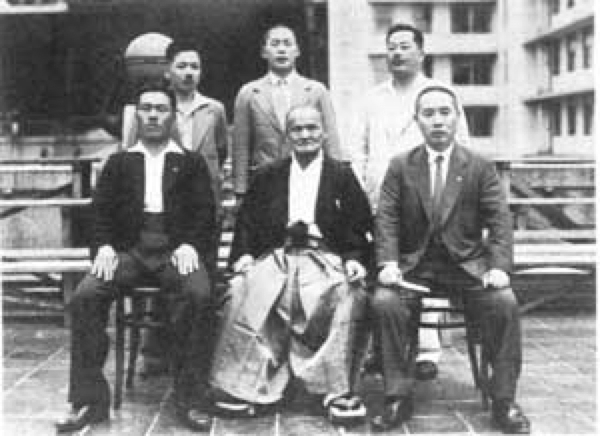
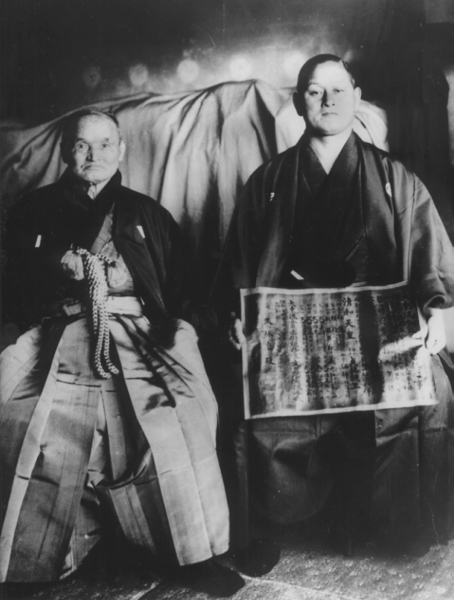 Takuma Hisa receives Menkyo Kaiden (“Certificate of Complete Transmission”)
Takuma Hisa receives Menkyo Kaiden (“Certificate of Complete Transmission”) Kubi-shime, “Budo Renshu” by Moritaka Ueshiba – 1933
Kubi-shime, “Budo Renshu” by Moritaka Ueshiba – 1933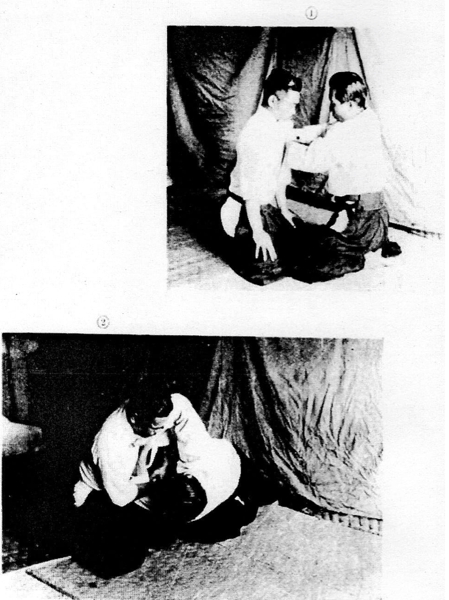 Kubi-shime, “Kannagara no Budo” by Takuma Hisa – 1940
Kubi-shime, “Kannagara no Budo” by Takuma Hisa – 1940 Kubi-shime, “Aikido Maki-no-Ichi” by Morihei Ueshiba – 1953
Kubi-shime, “Aikido Maki-no-Ichi” by Morihei Ueshiba – 1953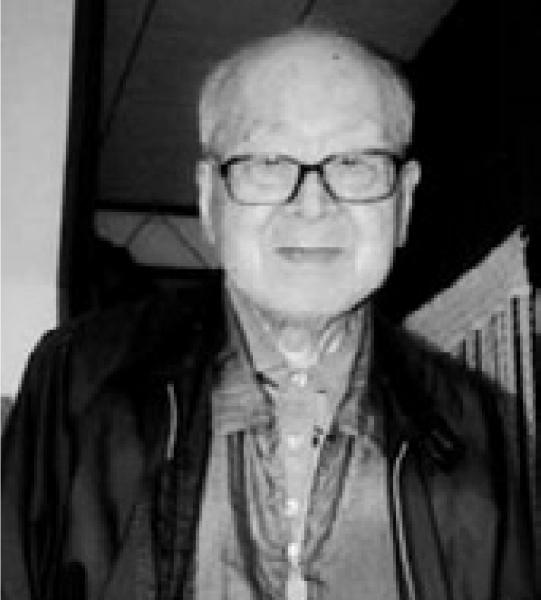
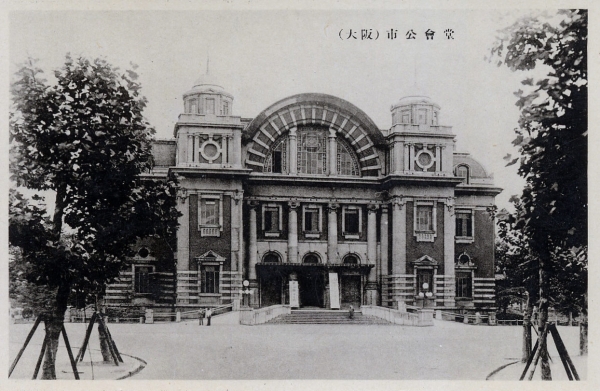 Osaka Central Public Hall, 1951
Osaka Central Public Hall, 1951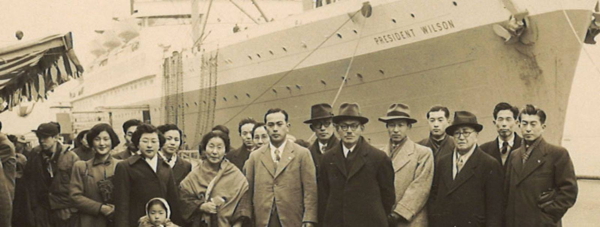 Koichi Tohei on his way to Hawaii in 1953
Koichi Tohei on his way to Hawaii in 1953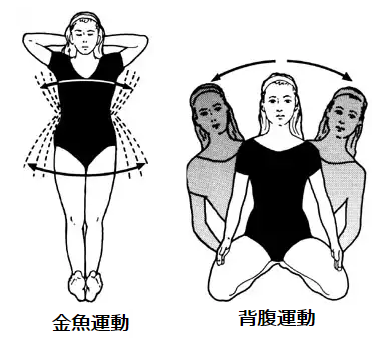 Two of the Nishi Health System exercises
Two of the Nishi Health System exercises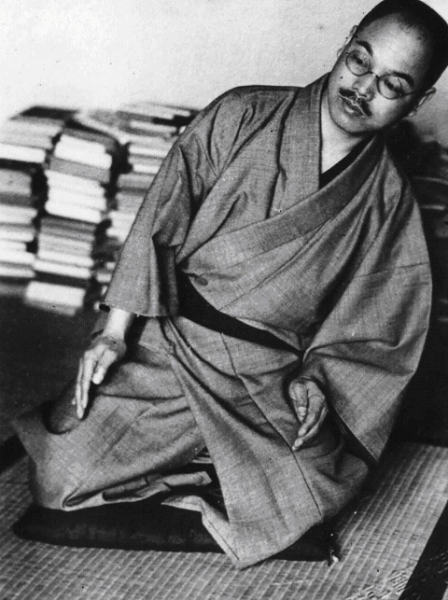 Katsuzo Nishi demonstrates the “Hifuku Undo” (背腹運動) exercise
Katsuzo Nishi demonstrates the “Hifuku Undo” (背腹運動) exercise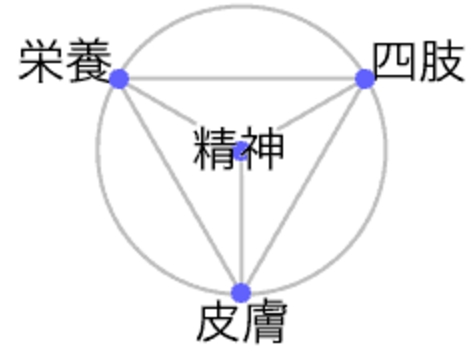 The Nishi Health System emblem and an explanation of
The Nishi Health System emblem and an explanation of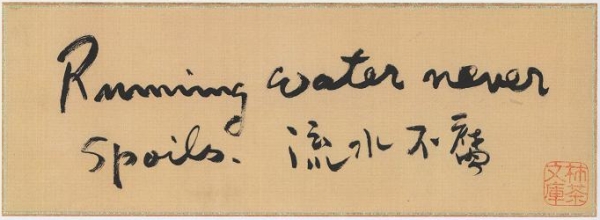 “Running water never spoils”
“Running water never spoils”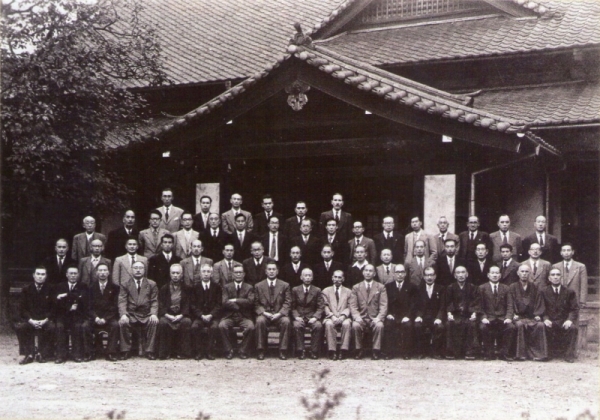 The Founding of the All Japan Kendo Federation, 1952
The Founding of the All Japan Kendo Federation, 1952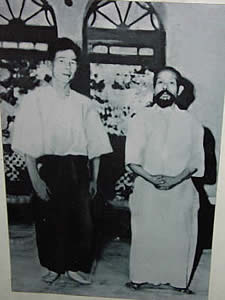 Seigo Yamaguchi (left) with Aritomo Murashige (right) in Myanmar
Seigo Yamaguchi (left) with Aritomo Murashige (right) in Myanmar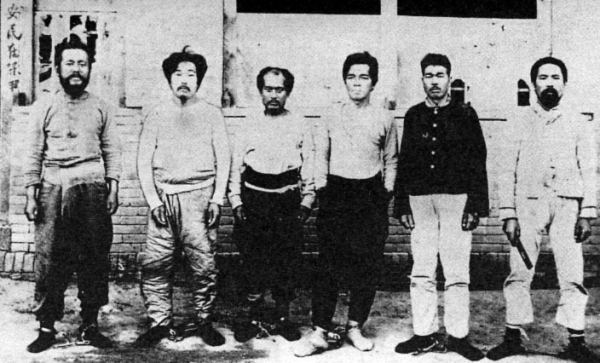 Under arrest in Mongolia
Under arrest in Mongolia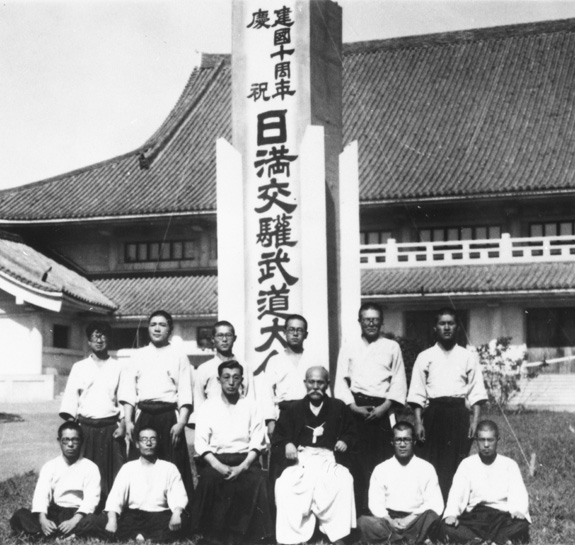
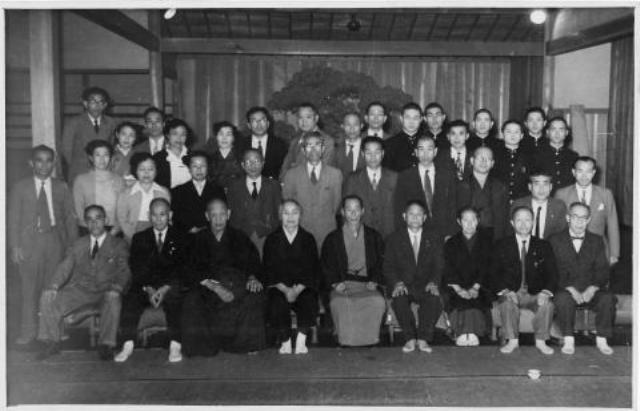 Hideo Sonobe (sixth from right) at the Kobukan (光武館) Dojo around 1954
Hideo Sonobe (sixth from right) at the Kobukan (光武館) Dojo around 1954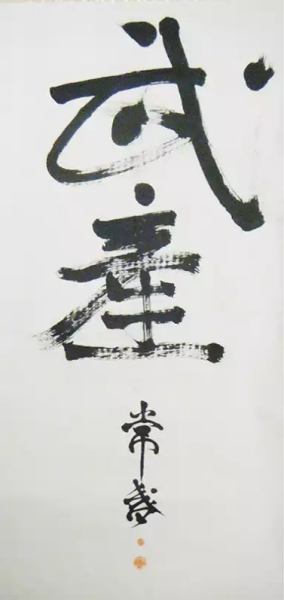 “Takemusu” calligraphy by Aikido Founder Morihei Ueshiba
“Takemusu” calligraphy by Aikido Founder Morihei Ueshiba